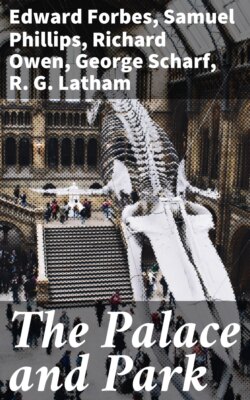Читать книгу The Palace and Park - Edward Winslow Forbes - Страница 18
На сайте Литреса книга снята с продажи.
VESTIBULE TO THE ITALIAN COURT.[18]
ОглавлениеThe decoration of the vestibule is founded on the very elegant Casa Taverna at Milan, by Bernardino Luini, a pupil of Leonardo da Vinci, and affords an excellent idea of the peculiar painted mural ornament prevailing in Italy at the commencement of the 16th century. The doors are from the Palace of the Cancellaria at Rome, by Bramante, the famous designer of St. Peter’s in that city, and the immediate predecessor of the great architects of the 16th century. The vestibule itself is rich in very beautiful water-colour drawings after the old masters, by Mr. West. These drawings are well worthy of study, since they afford admirable specimens of the manner of many old masters, who are but poorly represented in the National Gallery.
[18] See “Handbook to the Italian Court,” by M. Digby Wyatt and J. B. Waring.
Monument of
Lancino Curzio.
Madonna
della Scarpa.
Sacrarium of the
Maddelena from
Certosa.
Monument of
Lancino Curzio.
Madonna
della Scarpa.
Sacrarium of the
Maddelena from
Certosa.
Ground Plan of Italian Vestibule.
We now pass out of the gallery into the Vestibule, by turning through the pillars to the right. The monuments on the external wall of the vestibule afford excellent examples of the later Renaissance style. Amongst them may be particularly noted the monument of Lancino Curzio (nearest the gallery), from Milan, by Agostino Busti, evincing that delicate execution for which the sculptor was famous; underneath is the tomb of St. Pelagius Martyr, from Genoa; and, in the centre of the wall, the central altar of La Madonna della Scarpa, from the Leno Chapel in the Cathedral of St. Mark, Venice—an elaborate specimen of bronze casting, completed early in the 16th century by Pietro Lombardo and others. The upper part of the monument nearest the Nave is an excellent example of the Renaissance style, being the Sacrarium of the Chapel of the Maddelena at the Certosa, Pavia; the bas-relief in the centre is by Donatello, and the remaining portions of the composition are from Sansovino.
Façade of Italian Vestibule.
We have now completed our survey of one of the most interesting features of the Crystal Palace. We have performed our promise to guide the visitor through the various Fine Art Courts, bringing before his notice some of the principal objects that have adorned his road, and endeavouring, by our brief remarks, to heighten the pleasure he must necessarily have experienced from the sight of so noble an assemblage of architectural and sculptural examples. Much however requires patient examination and study—examination that will yield fresh beauty, and study that will be rewarded by permanent and useful knowledge. For guidance and help we refer the visitor to the handbooks of the several Courts. The mission of this little work, as far as the Fine Art Courts are concerned, is accomplished: and “The Guide Book” now only waits until the visitor has sufficiently recovered from his fatigue, in order to resume, in other parts of the building, the part of cicerone.
